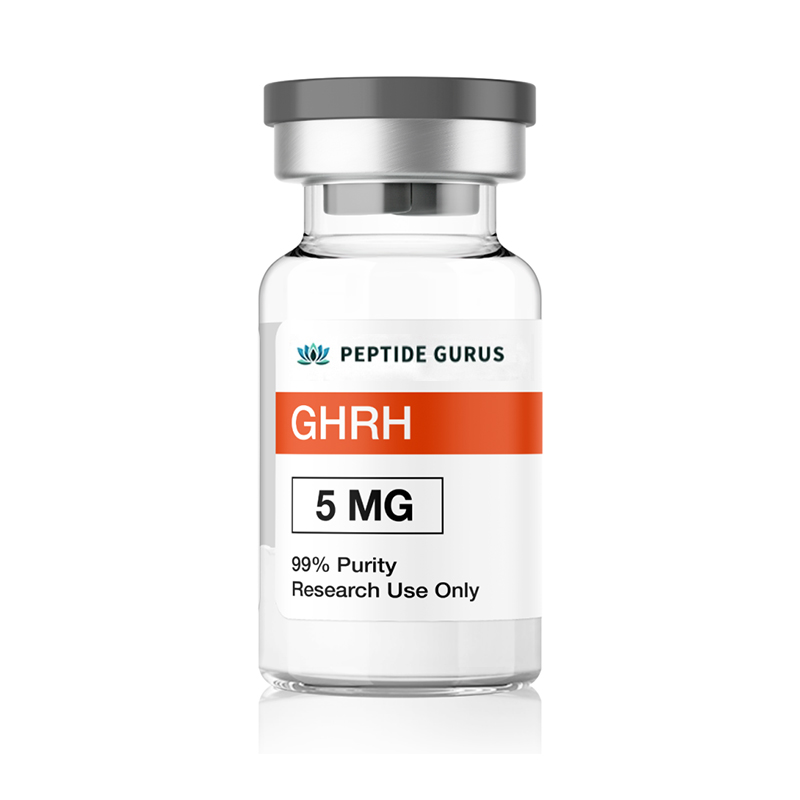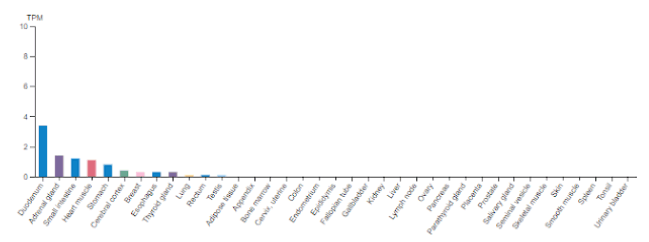



遊離(1)30 mlの細菌性水
資格のある注文があります500米ドル.
(カプセル製品、化粧品ペプチド、プロモーションコード、出荷を除く)
製品の使用:この製品は、研究化学物質としてのみ意図されています。この指定により、in vitroテストと実験室の実験のために、研究化学物質を厳密に使用することができます。このウェブサイトで利用可能なすべての製品情報は、教育目的のみを目的としています。あらゆる種類の人間や動物への身体導入は、法律によって厳密に禁じられています。この製品は、認可された資格のある専門家によってのみ処理される必要があります。この製品は薬物、食品、または化粧品ではなく、薬物、食品、化粧品として誤ってブランド化されたり、誤用されたり、誤ったりしたりすることはない場合があります。
成長ホルモン放出ホルモン(GHRH)は、視床下部の弓状ニューロンと呼ばれる神経によって放出される天然に存在するペプチドです。ペプチドは視床下部から下垂体に移動し、そこでホルモン受容体を放出する成長ホルモンに結合し、成長ホルモン(GH)の放出を引き起こします。 GHRHは、適切な成長と発達のために重要であり、除脂肪体重を増加させ、肥満を減らします(脂肪組織)。 GHRHは、筋肉の成長と長い骨の成長に間接的に関与していますが、炎症を調節し、痛みを緩和し、睡眠覚醒に重要な役割を果たすこともわかっています(日周期)。それは視床下部から拍動的な方法で放出されるため、GHの拍動性放出も引き起こします。この放出パターンは、成長ホルモンの機能、したがって生理学全般にとって重要です。

順序:DL-Tyr-DL-Ala-DL-Asp-DL-Ala-DL-xiIle-DL-Phe-DL-xiThr-DL-Asn-DL-Ser-DL-Tyr-DL-Arg-DL-Lys-DL-Val-DL-Leu-Gly-DL-Gln-DL-Leu-DL-Ser-DL-Ala-DL-Arg-DL-Lys-DL-L eu-dl-leu-dl-gln-dl-asp-dl-xiile-dl-met-dl-dl-arg-dl-gln-dl-gln-gly-dl-glu-dl-ser-dl-asn-dl-gln-glu-dl-arg-gly-dl-aLa-dl-arg-dl-dl-arg-dl-dl-dl-liu
分子式:c215h358n72o66s
分子量:5039.727 g/mol
Pubchem cid: 44134750
CAS番号:9034-39-3
同義語:成長ホルモン放出因子、ソマトクリニン、ソマトリベリン
GHRHは、他のホルモンとは異なり、いくつかの形で存在する可能性があります。実際、そのサイズは37〜44アミノ酸の範囲であり、44個のアミノ酸バージョンが最も一般的であり、GHRHについて議論する際に標準的な参照です。興味深いことに、これらのサイズの変化は、実験的証拠が識別できる限り、ペプチドの全体的な機能に影響を与えないため、37アミノ酸の長いバージョンは、より長いカウンターパートと同じ効果を生み出します。
GHRHには、年齢と発達の状態によって異なる基礎放出率がありますが、ホルモンのベースラインレベルに関係なく、拍動性放出のパターンは残ります。研究は、外因性の投与中であっても、GHRHの自然な脈動を保存することが、正常な生理学を維持し、特定の副作用を防ぐために重要であることを示しています。
GHRHは他のホルモンとは異なります。なぜなら、中枢神経系では、GHRHは視床下部のみに見られるからです。多くのホルモンはCNS全体に広く分布していますが、GHはそうではありません。しかし、GHRHは膵臓、心臓、胸腺、結腸などの末梢組織で見つかります[1]. It has also been found, pathologically, in certain tumors.

A number of analogues of GHRH have been developed in an effort to target some of the peptide’s effects while avoiding other properties. Alterations have also been made in order to to prolong the half-life of exogenously administered GHRH. Examples of GHRH analogues include CJC-1295, Sermorelin, and Tesamorelin. Tesamorelin was approved by the FDA in 2010 for the treatment of lipodystrophy (abnormal deposition of fat) in HIV.
A significant portion of the total amount of GH released by the pituitary gland is released during non-REM sleep (NREMS). Interestingly, GHRH administered exogenously promotes NREMS while suppression of normal GHRH release inhibits NREMS. Studies in mice suggest that GHRH is a critical factor in regulating the sleep cycle[2]. Interestingly, the balance between GH and GHRH secretion may help to explain why mammals cycle between NREMS and REMS (REM sleep) throughout the night. Studies in mice show that an increase in GHRH leads to increased NREMS and GH release. The increase in GH then leads to an increase in REM sleep and a decrease in GHRH secretion. This, of course, boosts GHRH release and starts the cycle over again[3]. Defects in this axis may help to explain a number of different sleep disturbances as well as why changes in sleep patterns can lead to long-term health problems.
Obstructive sleep apnea (OSA) is well-known to cause a number of neuroendocrine dysfunctions and can lead to everything from heart disease to cognitive dysfunction. Patients with OSA have been found to have severe deficits in GH and GHRH levels, a factor that may explain why OSA leads to cognitive dysfunction as well as obesity[4]. There is some thought that supplementing GHRH in patients with OSA may help them to recover faster from the condition and reduce the occurrence of long-term side effects. Interestingly, patients who have OSA and no cognitive deficits have normal GHRH levels[5]. This has lead scientists to investigate the role of GHRH in a number of neurological conditions (e.g. Alzheimer’s disease). Fortunately, CPAP therapy has been shown to improve the cognitive impairment and GHRH deficit associated with sleep apnea[6].
There is also evidence to suggest that the link between depression and sleep may be due to an imbalance between GHRH levels (to little) and levels of another hormone called corticotropin-releasing hormone (CRH). This imbalance has been shown to cause a decrease in short wave sleep while disinhibiting REM sleep[7]. These studies are in their most preliminary stages, but there is some hope that a deeper understanding of the GHRH-CRH balance may eventually lead to therapies that address not only sleep, but depression and its underlying mechanisms as well.
Traumatic brain injury (TBI) often affects the GHRH-GH axis and leads to substantial disturbances in sleep and mood[8]. In 2017, a phase 2 clinical trial studying the effects of GHRH analogue tesamorelin on sleep in individuals with TBI was undertaken. The study sought to determine if the peptide could produce changes in NREM sleep time compared to placebo. The results of the study have not yet been published, but the study underlines the keen interest in GHRH and its ability to regulate sleep.
GHRH, by stimulating GH release, is a potent muscle-building peptide and anti-obesity peptide. GH promotes the development of lean body mass, and supplementation with GHRH has been shown to do the same. Interestingly, research indicates that obesity causes a decrease in circulating levels of GH by affecting GHRH secretion[9]. Scientists have long known that increased obesity makes it harder to lose weight and affects everything from appetite to the way the body absorbs calories (obesity actually makes the body more efficient at absorbing calories). Now it appears that at least part of this anomaly results from a decrease in GHRH secretion in obesity. In other words, the more adipose tissue the body accumulates, the more GHRH secretion is reduced and the harder it is to lose weight. Scientists speculate that GHRH (or GHRH analogue) supplementation may be an effective means of jump starting weight loss until the cycle can be broken and endocrine regulation can be reestablished.
It has long been known that GHRH secretion is suppressed in response to both physical and emotional stress. In fact, careful studies have shown that stress, even psychological stress, can lead to delayed puberty, short stature, and depression. These changes in development can be directly linked to changes in GHRH levels, but the exact mechanism by which stress affects GHRH has been unclear until recently. New research suggests that the change in GHRH secretion is a result of neuropeptide Y levels, which actually cause changes in the neurons responsible for GHRH production and release. It is thought that the change in GHRH release is designed to help preserve energy by restricting growth during times of famine. Unfortunately, this system is activated during any stressful event and prolonged stress, particularly during childhood, can lead to severe restriction of development[10]. There is some question as to whether GHRH supplementation might be indicated for individuals with severe physical and emotional distress so as to offset the negative effects on growth, development, inflammation, and cognition.
Research in rats shows that GHRH is an effective way to relieve inflammatory pain. Interestingly, the peptide reduces pain without affecting any of the inflammatory mediators that lead to it[11]. This may be clinically relevant as it offers doctors that ability to fine-tune an inflammatory response, reducing pain without impacting other aspects that may be important, such as the presence of nerve growth factor.
Of particular interest is the role of GHRH in reducing the pain associated with fibromyalgia. Fibromyalgia is a difficult to characterize condition associated with widespread pain, fatigue, and sleep disturbance. It has been known for some time, however, that exercise can have a significant and lasting impact on fibromyaglia pain. This fact led scientists to believe that GHRH or GH deficiency may play a role in the development of fibromyalgia. GHRH administration reduces pain in this condition and, as pointed out above, may help to reestablish normal sleep cycles[12]. Though there are currently treatments available for fibromyaglia, they are relatively limited in efficacy. The use of GHRH to treat the condition could represent a breakthrough.
The exact reason that some men experience prostate enlargement (benign prostatic hyperplasia or BPH) has yet to be elucidated, but there is some evidence to suggest that chronic inflammation plays an important role in the process. Research in mice indicates that GHRH antagonism can reduce inflammatory cytokines in the prostate and actually lead to a reduction in the size of the gland. More importantly, GHRH antagonism appears to prevent hyperplasia in the first place, suggesting that GHRH antagonist therapy may be used to ameliorate BPH long before it becomes problematic[13].
Reduction in GH secretion and insulin-like growth factor-1 (IGF-1) are a part of aging but lead to decreased muscle mass and decreased strength in older people. Decreased strength leads to a number of problems such as gait abnormalities, bone density loss, changes in posture, and increased risk of falls and injury. Research in non-obese older men indicates that multiple daily injections of GHRH (or one of its analogues) significantly improves muscle strength and muscle bioenergetics without serious changes in blood lipid levels, weight, glucose levels, or overall health[14].
Interestingly, supplementing with GHRH also improves sleep in elderly patients and may lead to a decrease in cardiovascular mortality. The peptide also boosts cognitive function, likely by impacting sleep. Most individuals in these studies have also reported improved senses of well-being[15]. There is interest in extending these limited trials into long-term studies to determine just how far the benefits of GHRH extend in fighting the effects of aging and what, if any, side effects should be anticipated.
Research by L. Edmiston, M.D. for
ALL ARTICLES AND PRODUCT INFORMATION PROVIDED ON THIS WEBSITE ARE FOR INFORMATIONAL AND EDUCATIONAL PURPOSES ONLY.
The products offered on this website are furnished for in-vitro studies only. In-vitro studies (Latin: in glass) are performed outside of the body. These products are not medicines or drugs and have not been approved by the FDA to prevent, treat or cure any medical condition, ailment or disease. Bodily introduction of any kind into humans or animals is strictly forbidden by law.
PeptideGurus is a leading supplier of American-made research peptides, offering top-quality products at competitive prices. With a focus on excellence and customer service, they ensure a secure and convenient ordering process with global shipping.
CONTACT